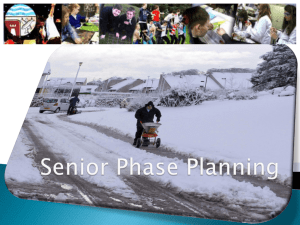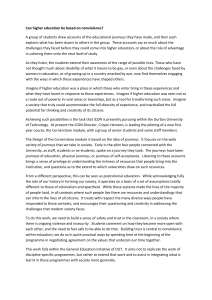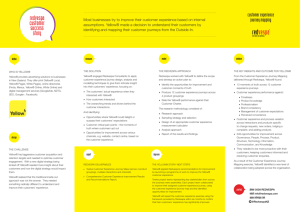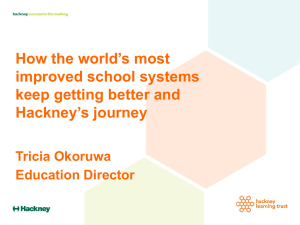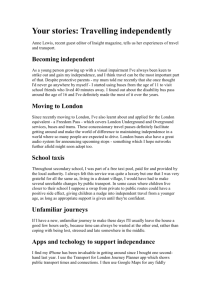Disclaimer: This learning journey was originally created as part of the... programme. Although the original purpose was to support learning...
advertisement
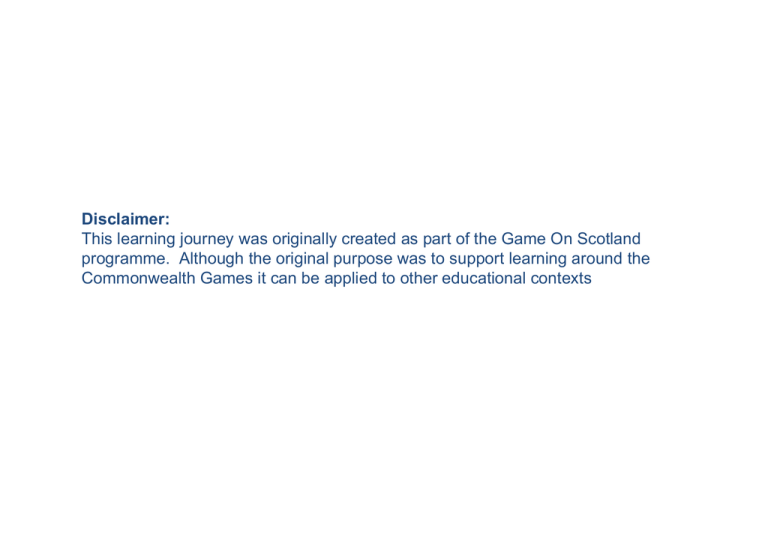
Disclaimer: This learning journey was originally created as part of the Game On Scotland programme. Although the original purpose was to support learning around the Commonwealth Games it can be applied to other educational contexts Learning journey – Inspiring Journeys Focus: Connecting journeys near and far Fourth CfE Level: Second / Third / Introduction: ‘5 Continents. 6 Faiths. 7 Languages. 8 Women. 1 daring ambition’: In 2009 eight women from eight different Commonwealth countries were recruited to undertake a journey to the South Pole: ‘The aim of the expedition was to demonstrate the potential of greater inter-cultural understanding, raise awareness of the work and value of the modern Commonwealth and to highlight the achievements of women around the world.’ (Call of the White, 2011, Felicity Aston) From this starting point, learners consider many of the aspects of this inspiring collective journey by the team of female explorers. An important aspect of this learning journey is that learners are challenged to undertake journeys in their local community and local landscapes. These can be small and repeated journeys, cumulative journeys, individual or collective journeys, or longer journeys – expeditions starting from their school / establishment or visiting a National Park for example. Connecting with people in the local community is encouraged, whether it be local athletes, business people, ex-pupils or learning establishments in the area. Journeys can be used to inspire literacy or creativity activities and curricular learning, and can model real and historic journeys by famous Scots. This learning journey contains the following learning experiences: Inspiring Journeys, near and far: – to the end of the world – journeys with John Muir – local legacies Prior learning: Interdisciplinary opportunities: Learners will hopefully have been introduced to one or more explorer from the past, ideally with a Scottish connection, such as John Muir, David Livingstone, or Birdie Bowers on the 1911 Scott Antarctica expedition. Learners will have an understanding of the reason for and history of the Commonwealth, and will bring their knowledge and experiences of their local area to the learning journey. Learning about Scotland – great Scots, local communities, protected landscapes such as our National Parks, Scotland’s sporting legends and our strongest Commonwealth sports. Activities can easily be adapted to suit any level and take into account a lack of, or greater, prior learning. www.gameonscotland.org Health and wellbeing – learning to travel safely, learning to recognize and manage risk appropriately. Religious and moral education – gender / equality issues and the differences between the status of women in different countries. Skills for life – working with others, time management and collaborative planning, communication skills, problem solving and developing creativity. 1 Capabilities: Successful learners: through opportunities for linking and applying different kinds of learning in new situations. Confident individuals: learners can pursue a healthy and active lifestyle, and further develop and communicate their own beliefs and view of the world. Responsible Citizens: by helping to develop respect for others, and learning to make informed choices and decisions. Effective Contributors: by developing resilience and self-reliance, and learning they can take the initiative and lead, and work in partnership and teams. Learning journey – Inspiring Journeys Focus: Connecting journeys near and far Fourth CfE Level: Second / Third / C Relevant Experiences and Outcomes: Health and wellbeing: (including journeys, safe travel, managing risk, MESP – physical activity and challenge being important in mental health) • • • • I understand that my feelings and reactions can change depending upon what is happening within and around me. This helps me to understand my own behaviour and the way others behave. HWB 3-04a / HWB 4-04a I am learning to assess and manage risk, to protect myself and others, and to reduce the potential for harm when possible. HWB 3-16a / HWB 4-16a I know and can demonstrate how to travel safely. HWB 3-18a / HWB 4-18a I am developing the skills and attributes which I will need for learning, life and work. I am gaining understanding of the relevance of my current learning to future opportunities. This is helping me to make informed choices about my life and learning. HWB 3-19a Social studies: (exploring local area, planning a journey, polar environments, comparisons between Commonwealth countries) • • • • • • • I can discuss the environmental impact of human activity and suggest ways in which we can live in a more environmentally-responsible way. SOC 2-08a Having explored the ways journeys can be made, I can consider the advantages and disadvantages of different forms of transport, discussing their impact on the environment. SOC 2-09a Having explored my local area, I can present information on different places to live, work and relax and interesting places to visit. SOC 2-10a I can make links between my current and previous studies, and show my understanding of how people and events have contributed to the development of the Scottish nation. SOC 3-02a I can investigate the climate, physical features and living things of a natural environment different from my own and explain their interrelationship. SOC 3-10a I can use a range of maps and geographical information systems to gather, interpret and present conclusions and can locate a range of features within Scotland, UK, Europe and the wider world. SOC 3-14a I can assess the impact of developments in transport infrastructure in a selected area and can contribute to a discussion on the development of sustainable systems. SOC 4-09a Religious and moral education: • • Through investigating and reflecting upon the responses of world religions to issues of morality, I can discuss ways in which to create a more just, equal, compassionate and tolerant society. RME 3-05a Through exploring a range of issues of morality, I can consider the responses of world religions to these issues and relate these to my own developing values. RME 4-05a www.gameonscotland.org 2 Learning journey – Inspiring Journeys Focus: Connecting journeys near and far Fourth CfE Level: Second / Third / Learning experience A: Inspiring Journeys – near and far: to the end of the world Introduction Possible learning opportunities / tasks Possible evidence Journeys in far off places undertaken by others can be used to inspire and influence journeys in your local area. From learning about the inspirational journey of the women of the Commonwealth Antarctic Expedition, learners explore their aims and inspirations, the places and environments, the necessary planning and funding, and legacies from such journeys. Learners may also consider and compare the professional and personal journeys of athletes competing in Glasgow 2014, while older learners or those working at a higher level can compare them to their own aspirations or those of someone close to them. Learners can: Produce a piece of creative writing / film / artwork or a drama which is an imaginary extract from their explorer’s travel diary or memoirs; work effectively as part of a team Stimulus ‘Call of the White’, Felicity Aston: http://www.youtube.com/watch?v=snhNM_rkxW4 Felicity’s next ambition (successfully achieved) was to ski alone across Antarctica: http://www.youtube.com/watch?v=xOYIq1V4woQ Training camp for the women’s expedition: http://www.youtube.com/watch?v=p8zJP9FoQDc Key learning Learners can: research a journey undertaken by an explorer which received public attention and interest reflect on their experiences and the impacts of their journey describe the route, distance, nature and challenges of the journey explain the legacy of the journey. www.gameonscotland.org Research the journey undertaken by Felicity Aston and the women of the 2009 Commonwealth Antarctic Expedition – or by a different explorer or group of explorers. Consider the nature of the journey – how was it ground-breaking, what were the main challenges, what landscapes, habitats, settlements (if any) did it connect? Consider the values promoted by this and other expeditions – how do they connect to Commonwealth Games Glasgow 2014 values of integrity, responsibility and endeavour or CGF values of humanity, equality and destiny? Recreate the journey to the South Pole through pictures, film, or as a drama acted out in the school grounds or local area. Useful resources http://www.felicityaston.co.uk/ Kaspersky Expedition website Additional resources: from BBC class clips – David Livingstone (discovery of Victoria falls) / Ranulph Fiennes (considering risk) Other journeys / explorers: Rob Roy way /West Highland Way Mark Beaumont, the man who cycled the world (2008) http://www.youtube.com/watch?v=MLQmlqma6PE Felix Baumgartner – mission to the edge of space (2012): http://www.bbc.co.uk/learningzone/clips/felixbaumgartners-space-dive/14151.html 3 Describe and explain the ways in which explorers’ experiences can have lasting impacts on people and society; evaluate the need for inspiring role models in society. Reflecting on learning Reflective questions for learners: How did the Commonwealth Antarctic expedition break new ground? What was John Muir’s most influential journey in the process of promoting conservation of wild places? Do the inherent risks of such journeys detract in any way from the clear benefits? Taking it further Learners could: plan a journey in the modern Commonwealth which raises awareness of an issue in which they are interested consider the challenges different athletes face to reach the Commonwealth Games. Learning journey – Inspiring Journeys Focus: Connecting journeys near and far Fourth CfE Level: Second / Third / Learning experience B: Inspiring Journeys – near and far: journeys with John Muir Introduction Journeys in your local area are inspiring and can provide a wealth of exciting exploration and discovery opportunities. These are supported by working towards a John Muir Award (Discovery or Explorer level). There is also potential to link to or develop a 3-18 places project (or once in Glow professional learning communities, input #olpp ) Learners can consider why people explore and push boundaries, and examine their own role in sustainability in both local and global contexts. Stimulus What motivates people to lead or be involved in expeditions? Tom Crean, Antarctic explorer, is described as an ordinary man who was involved in some of the greatest expeditions of the early 20th century: http://www.youtube.com/watch?v=dpyrn49wHB0 (this is sponsored by Land Rover but is very subtle). Key learning Learners can: • plan a journey or series of journeys (individual or collaborative) in their local area to explore the community, landscape, heritage and sustainable development of its resources • agree on and carry out a conservation activity in the local area. www.gameonscotland.org Possible learning opportunities / tasks • • Discover, explore, conserve and share through journeys in their local area – or through visits to a Scottish National Park. Undertake as a class the Discover level JMA (four days’ worth) or Explorer level (eight days’ worth). Consider why and how some wild places are protected, such as Antarctica, and our National Parks, and their local nature reserve. Collaborate with others to adopt a local place for regular outdoor learning around a curricular area, supporting teachers to develop a 3–18 places project. Possible evidence Learners can: Explain the nature and routes of their local journey(s) and describe John Muir and his legacies in global conservation and National Parks Share the experiences of and motivations for your local journeys through a range of media Demonstrate that they have engaged with each of the four challenges in their chosen local area – discover, explore, conserve, share. Reflecting on learning Useful resources JMA webpages: http://www.jmt.org/jmaward-home.asp Additional resources: Alistair Humphrey‘s micro-adventures, and his bigger adventures and their legacies: www.alistairhumphreys.com Catlin arctic team trekked to North Pole (2009) for scientific exploration of impacts of sea ice melting: http://www.bbc.co.uk/learningzone/clips/meet-the-catlinarctic-survey-team-members/7112.html http://news.bbc.co.uk/1/hi/sci/tech/7962022.stm National Parks http://www.lochlomond-trossachs.org/learning/ http://cairngorms.co.uk/learn/ 4 Link to Games Legacy – John Muir had his own targets in his mind, which he achieved over a number of years through example, determination, and conversations and writings. As a group, can the learners identify the impacts that some of the other journeys listed have had? Taking it further Learners could undertake similar exploration, or a micro-adventure, in their local National Park. Learners could consider a Duke of Edinburgh award, and former pupils could be invited to explore the local area alongside the learners. Learners could research expedition opportunities for their personal development, e.g. www.britishexploring.org Learning journey – Inspiring Journeys Focus: Connecting journeys near and far Fourth CfE Level: Second / Third / Learning experience C: Inspiring Journeys, near and far: local legacies Introduction Felicity Aston’s Commonwealth Antarctic expedition created legacies supporting women’s aspirations. John Muir’s expeditions and exploits created legacies for conservation. Legacies are left by all expeditions. This learning journey encourages young people to plan for sustainable legacies in their local community. Stimulus A requirement when being recruited for the Commonwealth Antarctic expedition was for each woman to promote the legacy of their success on returning to their own countries. One of the key legacies was to share the message that it is possible to aim impossibly high and still achieve success. Key learning Learners can: consider the values and process of creating a lasting impact in their local area – a physical or tangible legacy consider what the CGF values – humanity equality destiny – mean to them describe and give an example of a legacy drawing on their experiences in exploring the local area, in a team situation and with creativity, design a physical or tangible legacy, perhaps a metasaga – see resources section. www.gameonscotland.org Possible learning opportunities / tasks Create a pathway – physically, or in design and publication – to inspire people to enjoy your local area. Having undertaken local journeys, through a John Muir Award as above, develop creativity skills in designing a physical or tangible legacy from your local journeys and / or in your local wild place. Develop a metasaga (http://metasaga.wikispaces.com/file/view/Mestas aga_Westray_pdf.pdf ) around the theme of exploration and adventure for your school. Useful resources Metasaga from Orkney – an example: Metasaga wikipages A legacy of the adventure of moving away – focusing on language: http://www.bbc.co.uk/learningzone/clips/jackie-kayold-tongue/12213.html Jackie Kay’s poem about Scots moving away and missing their language. Glasgow 2014 Games Legacies/ values: http://www.glasgow2014.com/about-us/games-legacy 5 Possible evidence Learners can: Discuss ideas for a local legacy and evaluate suggestions based on a range of criteria Create a legacy in their local area Demonstrate a range of skills to work with the community to improve opportunities for others. Reflecting on learning Reflective question for learners:What could you as a group do to ensure more people in your community keep active and well through journeys in your local area? Taking it further Learners could: implement one or more of the ideas developed – harness the power of the community to implement positive change onsider applying for an Active Spaces grant – www.sportscotland.org.uk – to support this.
